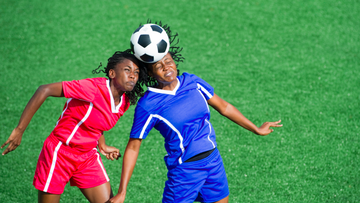Why It's Time to Remove the Stigma Around Soccer Concussions and Headgear
Dec 21, 2022
Despite advancing research on soccer concussions, there’s a pervasive stigma surrounding brain injuries and headgear to protect them. This stigma fosters a macho culture where players brush off head injuries, much to their detriment. It’s time to reverse that. This post will highlight why we need to embrace concussion protection and the catalysts for this change (i.e., players, soccer concussion headgear).
Soccer concussions aren’t rare
Brain injuries occur way more often than most realize. That doesn’t mean soccer is a “deadly” sport per se, but the risks are there, and numbers prove it.
A study published by Complete Concussion Management (CCM) found a rate of 0.23/1,000 athletic exposure (AE). That ranks soccer as the fifth-highest sport regarding concussion occurrence. Additionally, 22% of all soccer injuries are concussions (or other head injuries). So there’s a definite risk.
Yet, still, a stigma still exists around soccer concussions. Snoop around some online communities, and you’ll see members admitting there’s a stigma themselves.
They admit the standard protocol for many players after getting hit in the head is to stand up, dust themselves off, and resume play. They admit players have the reluctance to wear concussion headgear because it limits their heading ability or because they feel it does nothing to prevent concussions in the first place.
Some feel concussion headgear looks goofy, and players need to toughen up mentally instead of trying to protect themselves from every possible hit. But that same school of thought is why amateur and professional players now live with the consequences of brain injuries.
When soccer players “walk” concussions off
Soccer concussions rarely lead to long-term complications (assuming they’re handled correctly). We’ve highlighted players who suffered concussions and played unharmed for years, especially with the help of soccer concussion headgear. But other players weren’t so lucky.
You have names like Brianna Scurry and Ryan Mason who retired at the peak of their careers due to skull injuries. But a more tragic example of long-term concussion effects is that of Scott Vermillion, a former MLS player who passed away on December 25, 2020, at age forty-four.
He died not because of a recent brain injury but acute alcohol and prescription drug poisoning. But that’s only where the story begins. Vermillion had dealt with social withdrawal, substance abuse, and erratic behavior for a decade preceding his death. And, yes, you can attribute these troubles to various causes, but researchers have offered a more revealing and disturbing explanation.
When doctors at Boston University examined Vermillion’s brain posthumously, they discovered he had suffered chronic traumatic encephalopathy (CTE), making him the first American player to get the diagnosis. It’s well-established that CTE can lead to personality changes and substance abuse. The likely cause of his condition was numerous hits to the head that triggered slight yet irreparable brain damage.
The sad reality is that other players in the MLS and abroad (EPL, La Liga) have retired due to brain injuries, and some may share Vermillion’s fate. And that’s precisely why the stigma around soccer concussions needs to end. How can we prevent today's and tomorrow’s soccer players from dying young if we’re not actively reducing concussion risks now?
Soccer concussion risk is manageable
We can’t prevent all concussions in soccer (or any sport, for that matter). But we can make soccer safer than it is with protocols we already know make a difference. These safety measures can help players unleash their full potential with far less risk of brain injury.
Established ways to minimize soccer concussion risk
Attitudes toward soccer concussions are changing, but too slowly
The culture of “shake it off, I’m fine” is starting to change. Several players have begun wearing soccer concussion headgear, many of whom have made our ExoShield their headguard of choice over the years. They include former legends Wayne Rooney and Petr Čech and even young superstars such as Bethany Balcer. That’s promising to see.
But the soccer world still has a lot of work to do. Coaches, players, and parents need to encourage an environment where wearing concussion headgear and reporting symptoms isn’t a sign of weakness. When that becomes the norm, we’ll create a safer future for those who play the beautiful game.
Get the best head protection possible with our ExoShield concussion headguard.
